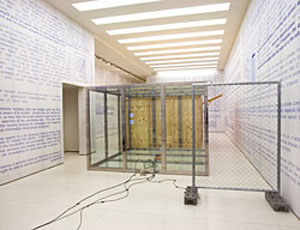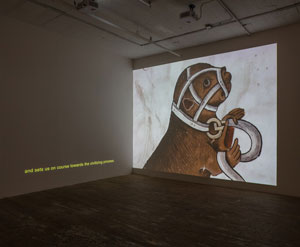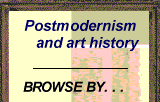Dead Giveaway
John Haberin New York City
Rirkrit Tiravanija, Mary Helena Clark, and MoMA PS1
You know what they say about conceptual art: you can't give it away.
Rirkrit Tiravanija disagrees, and he should know. He has been giving it away for thirty years now, and people are, literally, eating it up. I have had his Thai curry more than once in the galleries and received compliments on his free t-shirts, with their cryptic but high-minded messages giving nothing away. If that has you nodding off, he has served strong coffee to museum-goers who might balk at the café's prices and invited others to make tea. He has built his own radio tower to get out the message. MoMA PS1 devotes more than a full floor to his high-minded career. 
I do not often think of ping-pong as a spectator sport, but Tiravanija sets out a table in the museum's two-tier gallery, so that anyone can play and spectators can look down as in an arena. Mañana Es la Cuestión, its surface reads, and people line up in a photograph behind it, forming a question mark in front of Mexico City's grandest cathedral. He relishes collaborators, and he sees tomorrow as an eternally open question. Just who will come together for an answer? Could it be you? That still leaves him front and center, and his menu may be getting old, but such is conceptual art.
Still hoping for a free lunch? Another artist offers up an ode to animal appetites, in the guise of something more puritan. "The only body part that does not elicit disgust is tears." It is a sad and lovely thought. It is also just one line in a not at all mournful video by Mary Helena Clark. Disgusting.
Feeling competitive? Table tennis is only a start. A year later, MoMA PS1 is a busy place. It manages five separate solo shows for the summer, plus "The Gatherers," but then the artists themselves suggest a certain hesitancy. Unfortunately, museum goers will, too. Now if only there were more to eat.
Generous or self-involved?
In truth, the opening line on giving it away was mine—an attempt to play on the nature of conceptual art. If there is only a concept, there is nothing to give away. That is not true for all conceptual art, which can be physical indeed, and it is not true either for Rirkrit Tiravanija. His retrospective includes old pots and bottles that went into his curries, looking only mildly disgusting, and the show's largest room is set out spotlessly for cooking anew. He serves curry only on weekends during the course of the show, and coffee is available only late Fridays, but you can make tea anytime. Come on a Monday, and you can probably snag the ping-pong table (but no t-shirts).
Tiravanija will always be torn between the physical and the conceptual, what a past show called "theanyspacewhatever." The show opens with a wooden shed that replicates the layout of one of his earliest exhibitions. Sure enough, its first room is cluttered with memories cast in chrome—an old TV, VCR tape, crumpled clothing, and an Andy Warhol silkscreen of Chairman Mao. Sure enough, too, its second room lies empty. Back in 2007, I reflected at length on what it means to be an idealist in mainstream art institutions, and I leave it to you to read more for the full story. Here I ask only how that plays out at MoMA PS1.
For one thing, he sees himself as catering to basic human needs, like food and clothing, and he has replicated his bedroom for a promise of shelter—like the artist known as Puppies Puppies in the lobby gallery of the New Museum not long ago and Andrea Zittel before her. Yet needs are immediate, and that bedroom is long gone. He sees his work, too, as for all the senses, including taste and smell. Yet it depends on the bare fact of familiar objects. He sets out the instruments of a rock band, quality instruments at that, for others to play, along with proper recording equipment. I did not dare to pick up a guitar, but music and silence alike are in the air.
For another, it can grow seriously self-involved. You cannot have slept in his bedroom or on an orange mat, here topped by a backpack. He carried them on his way to an exhibition, sleeping where he could and walking on open ground. Was that humility or all about him? The question dogs all his work—and an entire movement devoted to giving things away, Relational Esthetics. Just when does giving become a true collaboration with the receiver?
It can also devolve into nostalgia. Back in his chrome days, Tiravanija also cast the urinals at CBGB. I miss the place myself, but not that much. All the same, art for him is political, like the slogans on his t-shirts. One of my souvenirs from past shows reads Freedom Cannot Be Simulated. Paintings on newsprint read Fear Eats the Soul, Less Oil More Courage, and The Days of This Society Is Numbered. A wall-sized painting becomes a simulated brick wall, in the style of Philip Guston.
Yet it cannot be too clear or too political. You will not find Guston's KKK here, and that goes with the further tension between collaboration and taking a stand. As the retrospective's title has it, he is catering to "A Lot of People." No wonder he has always served mild curry. As an artist from Thailand born in Argentina and able to remember the bathroom at CBGB in New York, he knows at firsthand what it is like to build bridges. His work almost sinks under the tensions, and I came away without a freebie, a meal, or much in the way of insight, but the welcome was real.
The human animal
A cagier artist's warning about human appetites could even be true, if not for all or for all time. Mary Helena Clark may leave you wondering whether to turn away in disgust or to cry. She sees disgust as a refusal of one's animal nature, but also its epitome.  She tracks the wish to transcend and to embrace the body, human or animal, starting with teeth. She leaves it to others to sort out the contradictions, if they dare. She leaves it to you, too, to decide what she herself believes and to shed a tear.
She tracks the wish to transcend and to embrace the body, human or animal, starting with teeth. She leaves it to others to sort out the contradictions, if they dare. She leaves it to you, too, to decide what she herself believes and to shed a tear.
Words appear on a side wall, as the left half of a two-channel video, and more than halfway down, like subtitles. They change in response to the images at right, but never comment directly. They unfold silently, again like subtitles, but also like words without an author or a voice. They could be turning away from humankind itself, along with, as the work's title has it, Neighboring Animals. The images, too, do not tell an obvious story. They could be mere chance impressions or a natural history of raw flesh and real teeth.
They give due weight to natural history, including clinical studies of animal anatomy and appetites. They linger, too, over a reliquary for, supposedly, a tooth from Mary Magdalene. Piety, it appears, does not turn away from dentistry after all. Not that conflicting desires can ever go away. Footage lingers over the ornate jar but never its contents. Does science itself identify with its animal subjects or see scientists as superior?
You may not care, not as actual apes appear on camera, suitably charming. Humans appear, too, but in Medieval depictions as well-dressed monkeys, with their own appetites and charm. If the body elicits disgust, it also elicits desire. If Freud is right, disgust may itself fuel desire and desire disgust. Does it all come down to piety or basic instinct? Who knows?
An opening room takes you to the zoo, where people get to enjoy themselves, whether animals do or no. Human laughter emerges from windowless steel doors. One can imagine passing through the narrow space between them while the doors press in, like rusted steel from Richard Serra or nude bodies from Marina Abramovic. Do not even attempt it. The gallery forbids it, and it would leave you all too human.
Small sculpture putters along on the floor—deadbolts that slide back and forth or move awkwardly ahead. They are not going to lock you in. Photos could pass for shots of the room itself, sterile and framed. They actually show a hatchery, yet another scientific nurturing of the animal. Clark never lets on to her own degree of desire and disgust. Yet she tempts others to confess theirs.
Gathering as Assembly
A season or two later back at MoMA PS1, art seems all but forced on the artists, and it is hard to say whether they mean that as critique. One can forgive Alanis Obomsawin, for this is cinema, sixty years of it, and who can begin to take it all in? Only slowly can it take shape as indigenous Canadian art. In the process, ordinary people need do no more than speak to children and speak for themselves. The work itself has a slow pace that will grow on anyone. As a film's title has it, The Children Have to Hear Another Story.
Thanks to Bani Abidi in Pakistan, children are still waiting. They line the parade route for an unnamed entourage of motorcycles and limos that may never arrive and would demand unqualified obedience if it does. The museum's two-story lower gallery seems just right for an oversized display of applause, and the winding parade already asserts it importance, with security forces in pristine white. What it means as political statement or art I hesitate to say. Not much happens in Reserved—and no doubt it has already taken place in many countries many times before. Political power works, Abidi might say, because it is predictable, anonymous, and halfway entertaining.
Julien Ceccaldi may have already given in. This is "everyday digital subjugation and hyperconsumerism," the museum insists, with the accent on the everyday. It is "distorted" as well, which here might count as praise. It centers on a good-sized mural of a painting within a painting, as Adult Theater. The oversized woman is suggestively lying down and already licking her lips. Three figures sharing a raised steel platform next to it might be a museum worker, a curator, and a global explorer.
Or maybe not, but everything here is an imagined archetype of an alternative museum or a stereotype out of mass culture. I lost patience before I could decide. Upstairs, Whitney Claflin is up to almost anything short of soft-core porn. She seems unable to decide, and it makes for a puzzling but more intriguing show. Abstractions make a point of their spareness and white ground along with their brushwork and drips. A naked mannequin does a hand-stand like a circus performer in on the act.
Claflin makes it worth looking regardless for connections that may not actually exist. Put it down to the summer doldrums and real talent. Sandra Poulson has more focus, and it allows her truly to take flight. Based in Luanda, London, and Amsterdam, she is not out to map contemporary art, but she has a way of taking in the past and giving it a place in the present. A crowded room bears furniture that appears assembled the wrong way, but good news: a cabinet, a desk, and a preposterous wooden toilet sit at odd angles, and the outline of a face in wood appears carved into a t-shirt, for This Bedroom Looks Like a Republic!
After all that, "The Gatherers" could be that rarity—a group show that will try anything once but sticks well enough together. Tableware from Tolia Astakhishvili and Dylan Peirce, a junction box from Klara Liden, and motherboards in their ratty cases from Selma Selman might each belong to a single artist. Together, the artists are gathering what becomes the detritus of its own assembly. Ser Serpas speaks of a corpse, and others might well have kept the wrapping and thrown the work away. Texture may count most of all. Worst comes to worst, Poulson has supplied the furniture to put it all away.

Rirkrit Tiravanija ran at MoMA PS1 through March 4, 2024, Mary Helena Clark at Bridget Donahue through March 23. The remaining solo shows at MoMA PS1 ran through August 25, 2025, "The Gatherers" through October 6. A related review takes in Tiravanija's generous offers.




